Performance Reporting — Continued
Goal 1: BC Employment and Assistance Clients Achieve Independence
Through Sustained Employment
Objective
Applicants enter into Employment and Assistance Agreements
as a condition of eligibility |
Strategy
Establish Employment and Assistance Agreements for all BCEA
clients |
Measure 1.1: Number of Employment and Assistance Agreements
completed for new and existing clients
Results
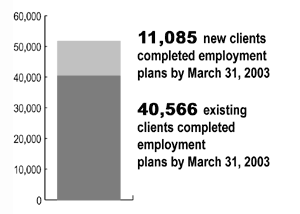
| 2002/03 Target |
Results |
| All BCEA Employment and Assistance clients
have signed Employment and Assistance Agreements |
11,085 of new clients
and
40,566 of existing clients have Employment Assistance
Agreements
|
Description
This output measure reflects the ministry's efforts to support
clients in completing employment plans, which were introduced
in September 2002. Employable persons are expected to be actively
engaged in work-related activities, as set out in their individualized
employment plans. These plans were originally called Employment
and Assistance Agreements and included both an employment plan
and an application for income assistance. Employment plans identify
the concrete steps clients will take to find employment, including
participation in job placement and training for jobs programs.
When employment plans were introduced, the ministry anticipated
that 77,000 existing income assistance clients could be actively
engaged in work-related activities. These clients were contacted
and 40,437 of them completed employment plans by March 31, 2003,
along with 11,377 new clients. Subsequently, employment plans
and applications came to be treated separately.
The ministry continues to refine its performance measures to
ensure that the critical measures are reported and that, as much
as possible, performance measures are outcome oriented. As a result
this measure will not be reported in 2003/04. Instead, outcome
measures for employability programming — i.e. the Job Placement
Program and Training for Jobs Program pilot — will be included
in the 2003/04 Annual Service Plan Report.
Why this Measure is Important
The Employment Plan is used to assist BCEA clients in moving
toward and finding sustainable employment, independence and self-reliance.
Moving income assistance clients to employment supports the ministry's
mandate and government's strategic priority of building a vibrant
economy.
Data Reliability and Assumptions
Source: Ministry database.
Data reliability is high, as the ministry tracks the completion
of employment plans in each client's file.
Existing clients are defined as those who were on the caseload
as of September 30, 2002, when Employment and Assistance Agreements
were introduced. New clients are defined as those who began receiving
income assistance after September 30, 2002 and before the end
of the fiscal year.
Objective
Clients find employment through work search and job placement
services. |
Strategy
Provide work search and/or job placement services to eligible
clients |
Measure 1.2: Percentage of clients leaving BCEA for employment
and percentage of clients who find employment through job placement
and do not return within 12 months
Results
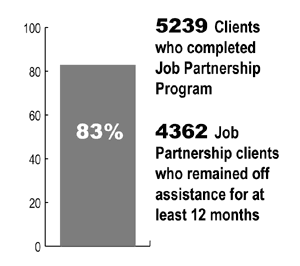
| 2002/03 Target |
Results |
| Establish baseline number of clients leaving
income assistance for employment |
Baseline established:
67%1
|
| Establish baseline percentage of clients
who find employment through job placement and do not return
to income assistance |
Baseline established:
83%
|
Description
These measures reflect both clients' success in finding employment
and the ministry's success in assisting clients to achieve independence.
According to the ministry's Exit Survey, 67 per cent of clients
who were independent of BCEA for at least six months, had found
employment. This established baseline for this part of the measure.
Ministry statistics also indicate that 83 per cent of job placement
participants were independent of income assistance after 12 months.
This established a baseline for the second part of this measure.
The figure is based on the results of the Jobs Partnership Program
pilot and the Job Placement Program.
The Job Placement Program — which was implemented in July
2002 following completion of the Jobs Partnership Program pilot
— assisted clients to obtain employment quickly by connecting
them with employers, and provided the necessary supports to maintain
employment. Job placement programs are delivered through contracted
service providers, whose payment is based on the number of clients
who achieve independence through their program.
Why This Measure is Important
Moving income assistance clients to employment supports the ministry's
mandate and government's strategic priority of building a vibrant
economy. Research indicates that the likelihood of returning to
income assistance decreases significantly for clients who maintain
financial independence for at least six months.
Improvements To Measure
The ministry has refined this dual measure to more accurately
assess the movement of clients from BCEA by expanding the measure
to include those who leave for education, training or other opportunities.

New Measure (2003/04): Per cent of Job Placement (JP) clients
who remain independent of income assistance for at least six months
Trend data is not yet available for this measure. Preliminary
data from the Job Placement Program indicates that as of March
2003, the ministry had referred 30,170 clients to the Job
Placement Program, of whom, 3,779 had achieved at least one month
of independence from income assistance.
| New
Measure |
2002/03 |
2003/04 |
2004/05 |
2005/06 |
| Per cent of Job
Placement (JP) clients who remain independent of income assistance
for at least six months |
Targets |
80% |
80% |
80% |
80% |
Results |
83% |
n/a |
n/a |
n/a |
The target for 2003/04 is 80 per cent of Job Placement clients
remaining independent of income assistance for at least six months.
Using the ministry Exit Survey results and a combination of Job
Partnership Program pilot and Job Placement Program results, the
2002/03 baseline for this measure is 83 per cent. This number
may shift as Job Partnership results no longer contribute to the
annual average.
Data Reliability and Assumptions
Source: Ministry database.
Data reliability for the new measure is high. It is based on
clients being off the caseload for at least six months, which
is verified by the ministry.
Other Comments
The model for the Job Placement Program is unique to B.C. and
was built on lessons learned from the Jobs Partnership Program
pilot.
Objective
Clients acquire specific job skills through short-term targeted
training for employment |
Strategy
Provide specific skills-training for the labour market to
eligible clients |
Measure 1.3: Percentage of clients trained, percentage of trained
clients employed after six months, and percentage of clients who
find employment through skills training and do not return within
12 months
Results
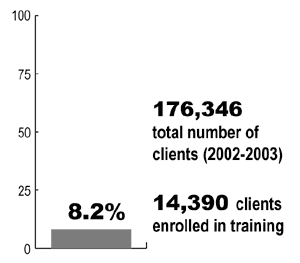
| 2002/03 Target |
Results |
| Establish baseline number of clients who
are employed six months after completing skills training
Establish baseline number of clients who find employment
through skills training and do not return to income assistance
|
The program was launched in December 2002,
so full-year results for the baseline were not yet available. |
Description
The ministry's major training initiative — the Training
for Jobs Program pilot — was under development through much
of the fiscal year. Consequently the results presented here are
for the training programs in place prior to its introduction.
The ministry recognized that improvements could be made to these
programs as the results indicate. The 14,390 clients who enrolled
in training during 2002/03 represented a total of 21,710 course
seats, reflecting the fact that many clients participated in more
than one training program. The most popular courses included career
planning, adult basic education, workplace-based training, and
English language training.
To assess the impacts of its training programs, the ministry
wanted to examine how many training participants were employed
six months after completing training, and how many remained employed
for 12 months. To measure this, a full year must elapse before
the 12 months of independence can be assessed. Consequently, at
the time of this report's preparation, figures were not yet available
for clients trained in 2002/03. Therefore, a baseline could not
yet be established.
The ministry conducted a study in May 2001, which revealed that
approximately 35 per cent of clients enrolled in training programs
in May 1999 achieved 12 months of independence and 52 per cent
reached 24 months of independence. The same study showed that
clients who did not participate in any form of training achieved
similar results. Training programs offered under BC Benefits did
not significantly increase clients' chance of becoming independent
from income assistance. Consequently, the ministry undertook major
changes to the delivery of its jobs training programs during 2002/03.
Therefore, a baseline could not yet be established. In December
2002, the ministry launched a performance-based Training for Jobs
Program pilot, as part of the ministry's commitment to more results-oriented
training.
Why This Measure is Important
Moving income assistance clients to employment supports the ministry's
mandate and government's strategic priority of building a vibrant
economy. Random assignment studies show that the most effective
way to assist clients to leave income assistance and increase
their earnings is through programs that place clients into employment
and provide supports and training to enable them to stay in that
employment.
Improvements To Measure
The ministry has refined this triple measure in two ways: first,
to focus on the achievements of the Training for Jobs Program
pilot in supporting clients to leave income assistance; and second,
to refine the definition of independence to include those who
remain independent for at least six months. Research shows that
those who are able to maintain financial independence for six
months after leaving income assistance are likely to remain independent
for longer periods of time. Using six months rather than 12 months
for this measure will allow the ministry to obtain more up-to-date
information on the impact of its programs and make any necessary
improvements more quickly.
The ministry links employable clients directly to employment
opportunities through two key programs: the Job Placement Program;
and the Training for Jobs Program pilot. The Job Placement Program
focuses on placing clients directly into employment and supporting
them to maintain employment. Launched in December 2002 as a pilot,
the Training for Jobs Program provides specific skills training
and job placement for clients who have experienced difficulty
in maintaining sustainable employment.
New Measure (2003/04): Per cent of Training for Jobs clients
who remain independent of income assistance for at least six months
The Training for Jobs Program pilot was launched in December
2002. As a result, six-month results were not yet available by
the end of the fiscal year.
| New Measure |
|
2002/03 |
2003/04 |
2004/05 |
2005/06 |
| Per cent of Training
for Jobs clients who remain independent of income assistance
for at least six months |
Targets |
N/A |
Establish
Baseline |
|
|
Results |
Training for Jobs program pilot was launched
in December 2002. Full-year results were not yet available |
|
|
|
Data Reliability and Assumptions
Source: Ministry database.
Data reliability for the new measure is high, as it is based
on clients being off the caseload for six months, which is verified
by the ministry prior to contractors being paid.
Other Comments
In developing the Training for Jobs Program pilot, the ministry
considered British Columbia's experience with labour market programming
for income assistance clients and conducted a literature review
of job training programs in other jurisdictions. Based on this
information, the Training for Jobs Program pilot incorporated
key elements of a mixed approach program. The program supports
the ministry's goal of providing clients with opportunities to
acquire specific job skills through targeted training, integrated
with job placement, and retention strategies.
Objective
Persons with disabilities find employment through employment
programs specifically tailored to meet their needs |
Strategy
Design employment programs for persons with disabilities |

Measure 1.4: Percentage of Persons with Disabilities (PWD) leaving
BCEA for employment
Results
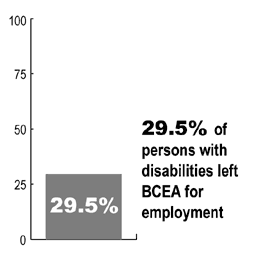
| 2002/03 Target |
Results |
| Establish baseline number of persons with
disabilities leaving BC Employment and Assistance for employment |
Baseline established:1
29.5%
|
Description
This measure indicates that approximately three in every ten
persons with disabilities who stopped receiving income assistance
during the fiscal year left for employment. This establishes a
baseline of 29.5 per cent. Persons with disabilities also left
to go to school, due to changes in family status or changes in
financial need. The ministry supports persons with disabilities
to achieve independence through the programs and services offered
under the Employment Strategy for Persons with Disabilities (ESPD).
Why This Measure is Important
Supporting clients to find sustainable employment is of critical
importance to the ministry because it assists individual British
Columbians in achieving their potential and in participating in
the province's vibrant economy. These efforts reinforce the ministry's
recognition that persons with disabilities want to participate
in the labour market to the best of their ability, or to volunteer
as they are able.
Improvements To Measure
The ministry has refined this measure to look at the percentage
of persons with disabilities on BCEA who have income from earnings.
This recognizes that a significant number of persons with disabilities
may work part-time and still receive income assistance —
particularly since new higher earnings exemptions were implemented
in 2002/03. The ministry encourages persons with disabilities
to take advantage of volunteer and employment opportunities as
they are able.
The data source for the original measure is the BC Employment
and Assistance Exit Survey. The surveyed sample for 2002/03 contained
only 104 persons with disabilities, making it difficult to generalize
the results from the survey to the rest of the persons with disabilities
caseload. The new measure does not have this limitation.
New Measure (2003/04): Per cent of Persons with Disabilities
with employment income
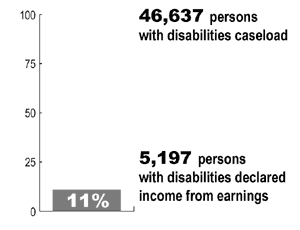
| New Measure |
|
2002/03 |
2003/04 |
2004/05 |
2005/06 |
| Per cent of persons
with disabilities with employment income |
Targets |
11.2% |
11.5% |
11.7% |
12.0% |
| Results |
11% |
n/a |
n/a |
n/a |
A target of 11.2 per cent was established for 2002/03, slightly
above the achieved 11 per cent of those persons with disabilities
who declared income from earnings in 2002/03. The full implementation
of the Employment Strategy for Persons with Disabilities is anticipated
to affect future results positively.
Data Reliability and Assumptions
Source: Ministry database.
Data reliability for the new measure is high, as the results
are based on caseload statistics.
Other Comments
One component of the Employment Strategy for Persons with Disabilities
(ESPD) is the Employment Program for Persons with Disabilities
(EPPD), which will be fully implemented by July of 2003. The EPPD
will provide integrated assessment, pre-employment services, employment
planning, job training, and employment services and supports to
enable persons with disabilities to gain, or enhance employment
to the greatest degree possible.
The EPPD is a comprehensive approach to employment programs for
persons with disabilities that is unique to British Columbia.
The ministry anticipates that this measure will continue to grow,
as the number of training and employment programs available to
persons with disabilities will expand with the implementation
of the EPPD.
The programs will be delivered through contracted services.
